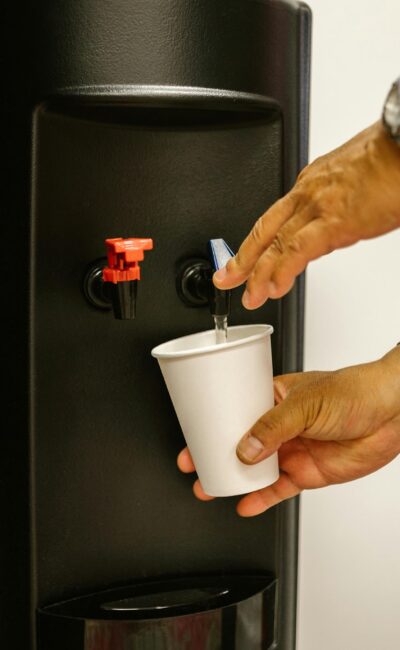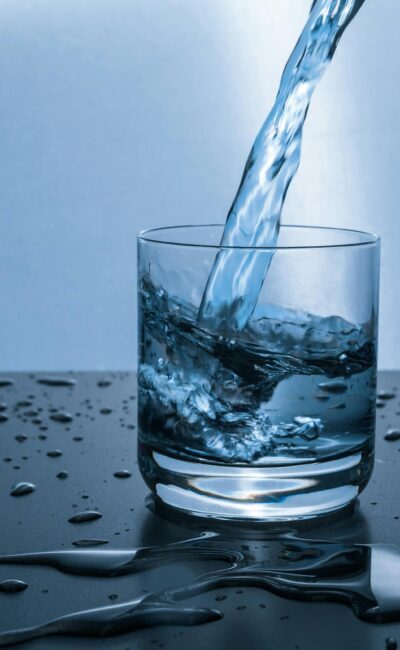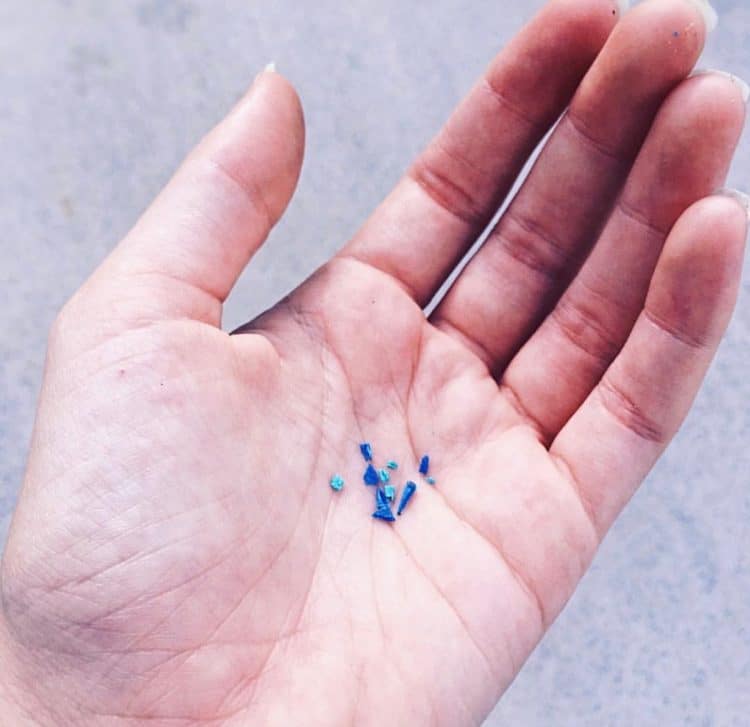Updated July 7 2024
Drinking water from your water line should be safe, but how safe is the water supply? The Environmental Protection Agency (EPA) sets specific regulations on over 90 contaminants, including chemicals, heavy metals, and bacteria found in drinking water. All of these are set to levels deemed safe for human consumption. Although, there are extenuating circumstances that change water quality depending on where you live and where your water is sourced. Plus, not all community water filtration system standards are the same.
A kitchen faucet water filter effectively removes contaminants to result in cleaner, safer, better-tasting drinking water. Here’s a basic overview of environmental conditions and signs to look out for to indicate if you purchase a sink water filtration system, or water filter pitcher, for your home’s tap water.
Tap Water Smells or Tastes Bad
First, use your senses to determine water quality. The way your water looks, tastes, smells, and even feels can all indicate if there are chemicals and pollutants in your water in levels of excess. This is not the case for all tap water, and there are harmful chemicals that can’t be detected by sense alone.
Chemicals, pollutants, and contaminants make their way through your water pipes and into your tap water. These are regulated through your city’s water utility, but the smell or taste they cause may turn you off from drinking the water. Common bad smells or tastes from tap water are chlorine, sulfur, and heavy metals.
Chlorine
Chlorine is used in the standard water filter system, today, to sanitize the filtered water and kill off bacteria. Common filtration systems currently include under sink water filter system and the countertop filter. This chlorination process is designed to help decontaminate the cold water you drink, but doesn’t always leave it tasting or smelling good. Plus, the process often leaves behind by-products that have been proven harmful to health and don’t remove chemicals or dissolved solids, like heavy metals, that may be found in your water.
Hydrogen Sulfide
The smell of sulfur or hydrogen sulfide is associated with the stench of rotten eggs, definitely not the smell you want when drinking filtered water on a daily basis. This gas is naturally present as a result of decay. Sulfur bacteria may also produce it in groundwater, well systems, or inside of water heaters. The smell of sulfur alone doesn’t necessarily indicate there’s a problem with your water quality. Still, it’s best to test for bacteria and nitrates, especially if your cold water line is connected to well water. is well water. Additionally, sulfur bacteria produces slime that allows other bacteria to grow and can clog plumbing systems over time.
Heavy Metals
Heavy metals regularly make their way into community water systems. If your tap water has a metallic aftertaste or smell, it’s best to have it tested. Examples of metals may include arsenic, lead, mercury, and chromium, among others. At high levels, these are toxic and cause adverse health effects in humans. Although your water utility is responsible for alerting you to high levels of toxicity, there have been several instances throughout history where reports of heavy metals weren’t reported accurately for residents who relied on water from their tap to drink and cook with on regularly.
Suppose your tap water has an unpleasant taste or smell or develops one over time. In that case, In that case, your best next step is to contact your local water utility to test it and learn what’s in your water and the amount of heavy metals and other contaminants present.
House Was Built Before 1986
Second, consider your surroundings to determine water quality. Environmental conditions that may indicate a need to install a kitchen water filter include: lead pipes, old, leaky plumbing systems, and residential areas situated near industrial runoff. These can all lead to contaminated water as pollutants leach into your water supply. Homes built before 1986 and older cities are more likely to have lead pipes, faucets, and soldering, lowering your chances of effortlessly pure water.
When water has high acidity levels or low mineral content, corrosion occurs that leaches lead into the water and makes its way to your tap. Water temperature, amount of wear in the pipes, and how long water has stayed in the pipes are all factors of determining how much lead enters the water.
Lead has such high toxicity that the Environmental Protection Agency has set the maximum contaminant level at zero in drinking clean water. It poses a high health risk event at low levels. Lead accumulates in the body over time and particularly affects young children and women who are pregnant. Unlike chlorine or hydrogen sulfide, lead is tasteless and odorless, which poses a problem if you aren’t sure of your water’s lead levels.
Lead exposure in young children can damage the central nervous system, learning disabilities, impaired hearing, and delayed blood cells’ formation and function. Adults are still susceptible to health risks, including increased blood pressure, decreased kidney function, and reproductive problems. If you live in an older home or a city with old pipes, installing a kitchen sink filter is a way to eliminate the presence of lead in the water you drink at home.
Furthermore, stagnant water in vacant homes or unused pipes breeds bacteria and requires a flushing process and testing prior to use. For example, the recent shutdowns due to Covid-19 have caused buildings, including vacation homes and rentals, to sit empty without fresh water running through the pipes for months. As a result, there’s a higher risk for bacteria that causes Legionnaires’ disease, which is spread through contaminated water and condensation from air-conditioning systems.
Tap Water Leaves Stains on Your Clothes
Third, assess changes after washing your clothes or dishes. The presence of certain chemicals in your drinking water can stain your clothes. Sometimes the water itself may have a light colorful or cloudy tint to it. Metals like iron, copper, and manganese are culprits that can stain clothing.
Iron leaves behind a rusty color. Look for stains on clothing after doing a load of laundry, or pour a glass of tap water and see if there’s sediment that floats to the bottom. These are indicators that higher levels of iron may be present. Copper leaves behind a blue-green stain and metallic taste when drinking it. Manganese also leaves a bitter metallic taste and is known to stain clothing black or dark brown.
If you notice discoloration on your clothes or the water that comes out of your kitchen faucet, you’ll likely want to have your water tested. Then, you should get a filter so you can drink purified water free of metals that alter the taste and quality.
House Was Built on a Water Well
Fourth, take extra precautionary measures if your home was built on a water well. Most people receive their drinking water from a public water system, through your city’s utility. This water is tested per EPA regulations and any extra standards set forth by your municipality. However, millions of people rely on private wells as their primary water source. As a result, well owners must test the water annually for bacteria, contaminants, nitrates, and varying pH levels.
This is especially important if your water well is near agriculture or industrial operations, as well as landfills and gas stations, where runoff can enter the well and contaminate the water at any time. A few ways to help prevent water well pollution include:
- Create a slope around the well area to drain the surface runoff
- Install a sanitary well cap or seal to prevent entry or unauthorized use of the well
- Keep updated and accurate records of well maintenance and disinfection processes
- Avoid mixing pesticides, fertilizers, or herbicides near the well
Relying on a water well for your drinking water requires stringent testing and upkeep to prevent pollutants and contaminants from entering the water. Getting a kitchen sink water filter is likely the most convenient and cost-effective option to ensure your household has clean, drinkable water.
Benefits of Having a Home Water Filter
All of these are signs that instantly alert you to whether you should or want to drink the water coming out of your tap. An unpleasant smell or odor tops the list. Sediment settling in the bottom of your glass, discoloration, and risk of harmful chemicals being present may also mean it’s time to consider filtering your home’s water.
Installing a sink water filter system in your kitchen allows you peace of mind that assures you’re drinking purified water that looks, smells, and tastes great. The Flo Faucet eliminates 80+ known harmful contaminants lingering in your tap water and pipes through its multi-stage filtration process. Transform your tap water into a refreshing hydration experience with a fast-fill that has twice the typical faucet filter’s flow rate.
A sink water filtration system also eliminates the need for plastic water bottles, which are costly to household budgets and the environment, while providing clean water every time you turn on the kitchen faucet. Now that people are at home more than ever, it’s best to have a sustainable water solution available at all times. By installing a kitchen sink water filter, you aren’t limited to the amount of filtered water you can access every day.
Sources:
- https://www.health.state.mn.us/communities/environment/water/wells/waterquality/hydrosulfide.html
- https://www.epa.gov/ground-water-and-drinking-water/basic-information-about-lead-drinking-water
- https://www.epa.gov/sdwa/secondary-drinking-water-standards-guidance-nuisance-chemicals
- https://www.cdc.gov/healthywater/drinking/private/wells/basics.html





